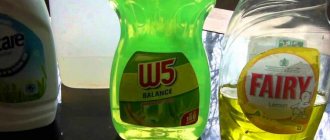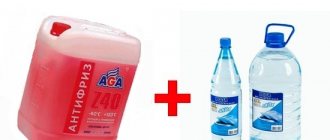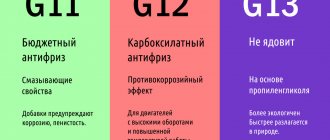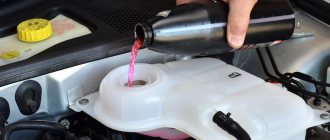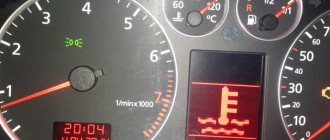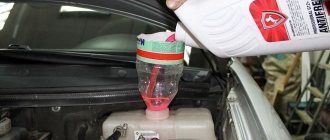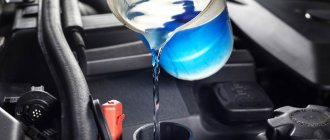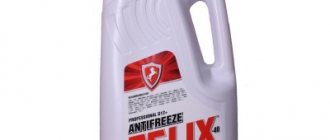Antifreeze is the basis for coolant (coolant), which is used in the cooling system of a car engine. The coolant itself is:
- a mixture of antifreeze concentrate and distilled water;
- water and concentrate are mixed in certain proportions (50/50, 60/40, etc.).
It is important to understand that different amounts of antifreeze and water in the coolant composition allow you to change the basic properties of the coolant: freezing and boiling points, the overall efficiency of the coolant, the quality of protection of cooling system parts, etc. For this reason, you need to know how to dilute antifreeze correctly. Read more in our article.
Coolant properties
Antifreeze is used not only for cars, but also for heating systems and aircraft engines. The liquid contains ethylene glycol and various additives
. They will improve not only the operation of the units, but also prevent their rapid wear. If the concentrate is diluted correctly, the coolant will provide the following conditions for the engine:
- the boiling point will be low or optimal;
- the service life will be long and without loss;
- rubber products will get rid of the aggressive influence on them;
- the boiling point will be high and the thermal conductivity will be high;
- anti-foam characteristics will be high.
If at least one of these conditions is not met, then your car will be repaired.
Why dilute a concentrated refrigerant solution?
The cooler maintains the temperature parameters of the working area of the power unit at the level of 90-110 degrees Celsius. If the temperature in the engine exceeds these values, the vehicle’s power unit will overheat and fail. This cannot be allowed.
Antifreeze must always be in a liquid state in order to be successfully distributed through the engine channels and remove excess heat from working parts. Water cannot cope with this function, since it freezes at 0 degrees Celsius. This also applies to antifreeze concentrate. The crystallization temperature of the technical mixture is at minus 13 degrees.
To change the properties of the coolant, it must be mixed with water and alcohols, as a result the mixture acquires new characteristics. By dissolving the coolant, you can reduce the crystallization threshold of the substance, down to 70 degrees with a minus sign. It is noteworthy that when the coolant is diluted, the boiling point of the technical composition decreases, so it must be mixed correctly to achieve the required performance properties.
What are the differences between antifreeze in appearance?
In order to distinguish antifreeze from plain water or to see the location of a leak in the cooling system, manufacturers add a dye. But, various other components are also added to them, which give other properties to the liquid. And in order to distinguish what properties the components will provide, they are painted in different colors. Coolers of European or Japanese brands are often used.
According to European standardization, G11 antifreeze is colored green
. Components such as inorganic additives, which are included in this composition, provide operation for a period of three years and are used for all types of radiators.
Antifreeze such as G12 is red in color (or from pink to burgundy). The additives in this solution act selectively because they are of the carboxylate type. Therefore, this liquid will cover with a protective layer only the surface that is affected by corrosion. With such a concentrate, the service life will be 5 years.
G13 antifreeze is painted yellow (possibly a brighter shade of yellow). Since it is propylene glycol, the price is an order of magnitude higher because it is more environmentally friendly. It is used for sports or forced engines of passenger cars or various motorcycles.
But the color of coolers according to the Japanese system indicates the temperature at which they freeze.
It is common to use green coolant. Such a cooler freezes at a temperature of minus 25. If the temperature is minus 25, then you need to use green. For those countries where the temperature is about 30 degrees, you need to pour red concentrate into the engine tank.
What is antifreeze concentrate?
Concentrated antifreeze lacks only one component: distilled water. All other components (ethylene glycol, additives and dye) are usually present in full.
Coolant concentrates are often mistakenly confused with pure ethylene glycol. Some manufacturers indicate on the packaging that there is only ethylene glycol inside. However, this cannot be true simply because ethylene glycol is a colorless liquid. And almost all concentrates are colored according to the generally accepted class markings (G11 - green, G12 - red or yellow, etc.).
Previously, colorless coolant concentrates were commercially available. It is likely that pure ethylene glycol was used in them. However, it is not advisable to use such a concentrate to prepare a full-fledged coolant. After all, without additives, metal corrosion and destruction of rubber pipes will accelerate significantly. And these compositions were only suitable for enhancing the low-temperature properties of already filled antifreeze.
What should you use to dilute the liquid?
There are two types of antifreeze sold in stores: diluted and in the form of a concentrate. The concentrate contains ethylene glycol, which freezes at a temperature of -13, so it is strictly forbidden to fill in undiluted coolant. Remember that antifreeze concentrate can only be diluted with distilled water, otherwise you will have many problems due to which the engine of your car will not receive the necessary protection and will break down.
Do not dilute with tap water, because it may contain various trace elements that, if they get into the cooler, will cause your car’s engine to corrode very quickly or may ruin its operation. There is no need to mix antifreeze concentrate of different brands and different colors
.
If you still decide to change the cooler class from one to another, then you will need to thoroughly rinse the radiator. Dilute the antifreeze concentrate with distilled water in the correct proportions and pour it into the cooling system through the radiator or expansion tank.
Can it be diluted with water?
If you dilute ordinary cheap concentrates with water, then it can cause scale, since the temperature reaches 100C and above, and the water will precipitate, and scale will certainly form on the tubes, which will adversely affect the entire cooling system, even leading to the formation of corrosion. If this happens, flush the system and replace the fluid. Therefore, in order not to take risks and not waste money, dilute this with distilled water.
Percentage ratio when diluting liquid with distilled water
If you need to properly dilute antifreeze concentrate, then you should completely read the instructions, which are usually included with the packaging by manufacturers. In no case do not pour more water than necessary, because then the cooler will lose its properties. Don't forget about the climate conditions in which you live.
The table shows how to dilute antifreeze concentrate:
| Water percentage | Concentrate percentage | Freezing threshold | Boiling threshold |
| 87,5% | 12,5% | -7 | 100 |
| 75% | 25% | -15 | 100 |
| 50% | 50% | -40; -45 | +130; +140 |
| 40% | 60% | -50; -60 | +150; +160 |
| 25% | 75% | -70 | +170 |
Don't forget to take care of your car, because in winter it especially needs protection due to the drop in temperature. If you take into account all the recommendations about the method of using coolant and carefully read the label on the package, you will save yourself from constant major repairs of the car.
← Previous material
Next material →
Breeding rules
Before you start diluting the concentrate, you must carefully read the recommendations on the packaging. You cannot increase the proportion of water yourself, as this reduces efficiency. You also need to take into account the operating conditions of the vehicle and climatic conditions.
There are generally accepted proportions for bringing the liquid to working condition in the water/concentrate ratio:
- 7/1, freezing point -7, boiling threshold +100;
- 3/1, freezes at -15, boiling threshold +100;
- 1/1 freezing threshold -45, boils at +130;
- 2/3 freezes at -50, boils +150;
- 1/3 freezing threshold -70, boiling +170.
It is strictly forbidden to mix antifreeze of different colors.
Red antifreeze Toyota
The name Toyota is on everyone's lips. This Japanese concern produces cars that are reliable in performance and affordable. To ensure that machines operate longer, smoothly and reliably, the manufacturer recommends using original technical fluids, including coolant. All products for this brand are produced at oil refining facilities in Europe and Japan. Toyota does not have its own factories.
Product Description
The question of which antifreeze is best for Toyota, according to the manufacturer of these cars, should not arise. Because there are special original formulations designed specifically for this brand. For example, Toyota Long Life Coolant. This is antifreeze, available in two forms: concentrate and ready-to-use liquid. It is based on polypropylene glycol and traditional technology.
The inhibitors contained in Toyota LLC effectively protect the cooling system from corrosion. The liquid has a low freezing point and perfectly removes heat from a running engine, creating optimal temperature conditions for its operation.
All traditional propylene glycol-based antifreezes that have the appropriate approvals can be considered analogues of the liquid.
Application area
If you are in doubt about what antifreeze to pour into a Toyota, you should always pay attention to the original one. After all, the manufacturer will not recommend anything bad for their cars. Toyota Long Life red antifreeze is suitable for both cars and trucks of this brand. Primarily designed for cars up to 2002. However, its use is also acceptable in newer models.
Other antifreeze from the Toyota line:
Release form and articles
- 08889-80015 Toyota Long Life Coolant RED (LLC)(concentrate) (plastic bottle) 1 l;
- 08889-80015EE Toyota Long Life Coolant RED (LLC)(concentrate) (plastic bottle) 1 l;
- 08889-80032 Toyota Long Life Coolant RED (LLC)(concentrate) (canister) 4 l;
- 08889-80014 Toyota Long Life Coolant RED (LLC)(concentrate) (canister) 5 l;
- 08889-80014EE Toyota Long Life Coolant RED (LLC)(concentrate) (canister) 5 l;
- 08889-80017 Toyota Long Life Coolant RED (LLC)(concentrate) (barrel) 60 l.
Instructions for use
Toyota red antifreeze concentrate must be diluted with distilled water before use. The optimal ratio is 50:50. It provides frost protection down to -40 degrees Celsius. In general, how to dilute and how to dilute antifreeze depends on climatic conditions. The concentrate content in the finished liquid can range from 33% to 70%.
As for ready-to-use Toyota antifreeze, it is intended for direct pouring into the car’s cooling system. Before first use after using another liquid, it is recommended to flush the system. How often to change this antifreeze in a car depends on the operating conditions. On average, the recommended interval is 40 thousand km or every 2 years. After factory filling, the first replacement should be made after 3 years.
How to spot a fake
This is not to say that Toyota LLC is often counterfeited. Its pink “brother” is more popular. However, in the case of branded liquids, you cannot be immune from anything. Here are some signs that will help you distinguish an original from a fake:
- high quality - no defects, traces of tampering, unevenness, glue drips, wrinkles or folds on labels;
- text written without errors, evenly and clearly, without smeared or erased areas;
- mandatory date of manufacture and bottling;
- the liquid itself is transparent, without sediment, red in color.
Reviews
David, 52 years old I use new Toyota antifreeze, Super Long Life. It has a much more modern composition and higher quality than the simple one. Well, you can change it less often. Just don't mix it with anything.
Vadim, 46 years old I advise everyone to use a concentrate rather than a ready-made Super Long Life cooler. Why? Because the price, to be honest, is a bit steep, and the concentrate is much cheaper. In addition, it can be bred in accordance with your weather; if there are no severe frosts, it will be even cheaper.
Arthur, 37 years old Long Life is an excellent antifreeze for Toyota. Never thickens, foams or boils. I use it like I bought a car, and I see no point in experimenting and looking for something else.
Ivan, 35 years old I have been using the original Long Life in my Toyota for a long time. I can say that in the five years that I have had this car, I have never had any problems caused by antifreeze. The cooling system is in perfect order, as is the engine.
How to spot a fake
Information on the canister labels
It cannot be said that original antifreezes, suitable only for one brand of car, are counterfeited as often as the most popular, universal, branded coolants are often counterfeited. However, this is not completely ruled out. Therefore, the coolant canister must be carefully inspected. Here are some signs that may indicate a fake:
- rough, uneven seams or defects in their area;
- a lid that does not fit tightly to the ring, scratches, chips, and other signs of tampering along its edges;
- unevenly glued labels, bubbles and folds on them, traces of glue;
- information that does not correspond to reality or contains errors;
- blurred text, uneven lines;
- unreadable release and bottling date.
If something in the appearance of the canister is alarming or raises doubts, then it is better to double-check. You should not pour antifreeze into the tank until you are completely sure of its quality.
HEPU antifreeze concentrate red P999 G12, 1.5 liters
I looked, and God knows what kind of antifreeze was filled in, it’s not green, not blue, it’s not clear what kind at all, when I went through the maintenance they changed it, and I don’t even know what was poured there, in general the solution was the most optimal, especially since I’ve already done this on 99th, I wasn’t ready to take it, I took the red concentrate G-12, from the old proven company HEPU, made in Germany, since my manual says max 10.5 liters, and I decided to use 1:1, that is, for 5 liters of distilled water
I will pour 5.5 liters of concentrate water, for severe winters -37 degrees, and you can’t mix antifreeze categories G-11 and G-12, different fractions are not interchangeable, and you can’t mix antifreeze by color
Green
and
Blue
don’t mix with
Red
and
Burgundy
m,
Yellow
, to be honest, I don’t know, the issue price
is 1883 rubles
SsangYong Rexton 2006, engine Gasoline 2.3 liter., 150 hp, AWD drive, Manual — other categories
Comments 32
I have a diesel. Will blue HEPU G11 approval MB 325.0 work? Hi all!
Hello Stas, pour the blue calmly, I filled the red one with G12, the flight is normal,
Yes, the blue G11 MB 325.0 is prescribed to me. What kind of company is it? I'm talking about HEPU. Not a leftist?
HEPU has never been a leftist, it is a German company, I poured it back in 21099 in the year 2005
Is it acceptable to mix two different antifreezes?
This is a really serious question, since there are many different coolants on the market, and their composition can vary significantly. In order not to provoke unexpected reactions, you can and should top up the composition of the same brand. Experiments in this part will, at a minimum, lead to premature wear of the cooling system.
To extend the “life” of a car engine, you need to give preference only to high-quality coolant products from well-known manufacturers. This approach will prevent the development of corrosion of aluminum structural elements.
Let us add that Russian cars are less sensitive to the water experiments of their owner, but modern foreign cars react very poorly to low-quality and diluted antifreeze.
How long can you ride “on the water”?
- A composition not intended for such manipulation was diluted with water. Then the antifreeze diluted with distillate must be replaced with factory liquid as soon as the street thermometer moves to negative values. But even at positive temperatures, water will only help for a while. Which? There are no official recommendations from manufacturers. The car owner determines the time period for himself, depending on how dear the car is to him.
- concentrate was poured into the tank. If the dilution was carried out according to the company's instructions, there is no need to replace the liquid. Simply, if the level drops more than expected, you need to top up the container with the composition diluted according to the instructions.
What should the density of antifreeze be?
After you have received all the necessary fluid indicators, you need to compare them with the indicators from the table. If the concentration of ethylene glycol is 85.4% and the crystallization temperature is -40 degrees, then the density of the mixture should be at least 1.104 g/cm3. By analogy, you can determine any value and find out at what density a particular freezing threshold of the composition will be.
For convenience, we present the normal density indicators for the most popular antifreezes:
- the density of Liqui Moly KFC liquid is 1.113 g/cm3;
- for Toras antifreeze OZH40 this figure is 1.087 g/cm3;
- Castrol Radiocool has a density value of 1.122 g/cm3;
- Mobil Antifreeze Advanced density ranges from 1.122 to 1.125 g/cm3;
- for Mannol Longlife AF12+ the standard value is 1.085 g/cm3.
Many antifreezes are made with a reserve, that is, their freezing point can be up to -60 degrees. We don’t have such cold Arctic winters, so such “coolers” can be diluted with water without a twinge of conscience in order to achieve the crystallization threshold of the composition at -35 degrees.
About mixing antifreeze with each other and water
So, if you are wondering whether it is possible to mix antifreeze, then I would like to immediately warn you that there is no clear answer to this question. It all depends on what exactly you are going to mix.
Is it possible to mix antifreeze of different classifications?
All coolants are divided into classes. According to the official standards introduced by the Volkswagen brand, there are 3 of them: g11 g12 g13.
G11 is based on ethylene glycol, which is supplemented by a small package of additives. Such coolants contain silicates and other inorganic compounds. In addition, they are characterized by the cheapest price among others.
G12 consists of ethylene glycol and carboxylate compounds. Provides more efficient heat dissipation due to higher quality additives. Used for engines subject to high loads.
The basis for g13 is polypropylene glycol. Of all the above, this is the most environmentally friendly and least harmful product, which is subject to rapid decomposition. It has the most expensive price and is not produced by domestic companies.
Remember that mixing antifreezes of different classifications is strictly not recommended - any specialist will confirm this. It's all about different compositions, when mixed, unpredictable chemical reactions can occur that can significantly damage the cooling system.
Is it possible to mix antifreeze of different colors?
If, again, we talk about classification, each variety is assigned a specific color by the manufacturer. This is necessary to make it easier for the buyer to distinguish between coolants of different classes.
The catch is that very often the colors of the classes of different brands do not match. g11, as a rule, has a green or blue color, g12 antifreeze is most often painted red, and for g13, for the most part, a yellow dye is used.
But this division cannot be taken as an axiom, since each developer assigns colors to his classes independently of others and has every right to do so. So green antifreeze may well have a “red” composition, and vice versa. Therefore, if you are wondering how you can mix antifreeze of different colors, there is only one answer - wisely. First, you need to carefully study the composition of each product, and if there are fundamental differences in the base or additives, it is better not to take risks. Just as it is better not to choose a coolant based on green or red color, arguing that the previous one had a similar shade.
Antifreeze - composition, application, features of use
Any antifreeze is, first of all, a coolant. The main task of the composition is to regulate the temperature of the engine and the entire system. In summer, antifreeze prevents the power unit from overheating and from freezing in winter. The substance acquires special properties due to the fact that it contains:
- distilled water (20-35%);
- ethylene glycol (80-65%).
To prevent the formation of corrosion and the onset of other negative processes, manufacturers add special additives to antifreeze. By volume, additives can be no more than 2%, otherwise the refrigerant will acquire harmful qualities (it will corrode rubber and plastic, metal).
Under what circumstances can you still add water to the coolant?
Despite the strictest prohibitions and restrictions, there are situations that leave no choice. It happens that the antifreeze has leaked, and there is simply nowhere to get a new one. I need to drive, but I really, really don’t want to damage the car. Under such circumstances, it will be possible to dilute the coolant with water. Here it is important to strictly follow one rule - the volume of water poured should not exceed the volume of antifreeze.
If the antifreeze has completely leaked out, then there is definitely no choice and you can fill the water completely. This will allow you to get to the nearest repair shop, but you should move very slowly.
